What if doctors have it all wrong?
Well, it wouldn’t be the first time.
In the 1800’s doctors recommended cough syrup containing heroin.
Is that a chronic cough, or are you just addicted to your cough syrup? In the 1940’s, mental disorders including depression and anxiety were being treated with frontal lobotomies.
You don’t really need that part of your brain, do you?
Yet, grave medical mistakes like these don’t happen in this day and age… or do they?
While it’s hard to compete with a medical mistake like having part of your brain removed, there’s an epidemic medical mistake that’s been overlooked for decades…
…and it’s likely one of the deadliest we’ve ever seen.
I’m referring to the medical mistake of using estrogen to treat many symptoms of menopause, including hot flashes and flushes.
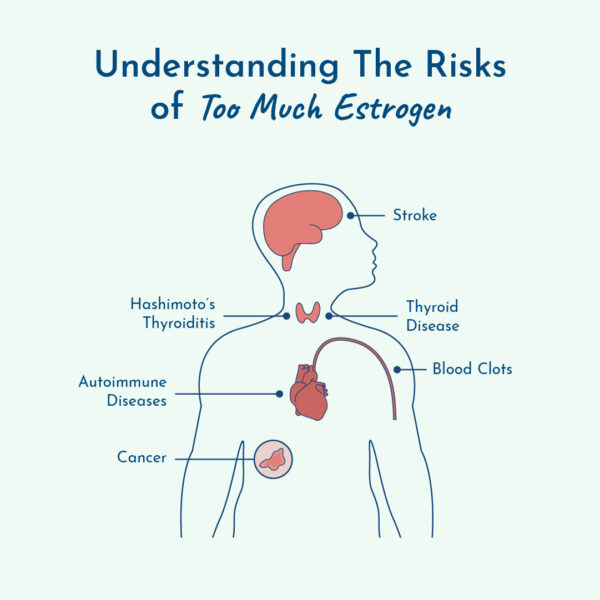
Sure, estrogen is effective at reducing the symptoms of hot flashes.
But, what about the well-established increased risk of diseases caused by estrogen, including:
- Cancer
- Hashimoto’s Thyroiditis
- Autoimmune Diseases
- Thyroid Disease
- Blood Clots
- Stroke
- Etc.
Apparently doctors are not concerned about those, and therefore, you shouldn’t be either.
That’s a little scary isn’t it?
Treating hot flashes with estrogen is kind of like treating depression with a lobotomy.
No, the existence of the frontal lobe of your brain isn’t the cause of depression any more than estrogen deficiency is the cause of your hot flashes.
The Hot Flash Estrogen Deficiency Myth
If estrogen deficiency was the cause of hot flashes, then it would make sense that women who suffer from hot flashes would be “more deficient” in estrogen than those who do not.
However, according to renowned hormone physiologist Dr. Raymond Peat, that’s not the case at all.
At menopause, there are a number of hormonal changes that occur, including:
- A natural decline in thyroid function.
- An inhibition of progesterone production.
- An increase in stored estrogen within cells/tissue.
- An increase in activity of the estrogen producing aromatase enzyme.
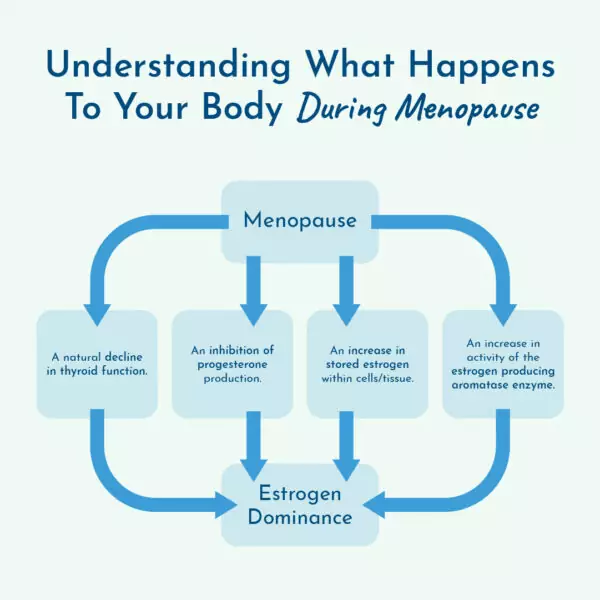
While estrogen production may decline, progesterone production declines more severely resulting in estrogen dominance.
(Note: Estrogen levels at menopause are often 50 times higher than what is measured in the blood, as discussed in this article on hypothyroidism and estrogen.)
It’s important to understand that it’s the balance of estrogen to progesterone that matters most.
In menopause, the more estrogen dominant and progesterone deficient you become, the greater the danger to your thyroid health.
Dangers of Estrogen to Your Thyroid Health
There are certain points in a woman’s life when hypothyroidism either develops, or worsens.
Menopause is one those times due to the thyroid-suppressive effects of estrogen dominance.
Estrogen dominance blocks thyroid function and drives hypothyroidism in a number of ways, including:
- Inhibiting the proteolytic enzymes that allow your thyroid gland to release its thyroid hormone, directly blocking your thyroid gland.
- Blocking your liver from converting inactive T4 thyroid hormone into the active T3 thyroid hormone your cells need to survive.
- Blocking your metabolism and preventing you from using thyroid hormone efficiently.
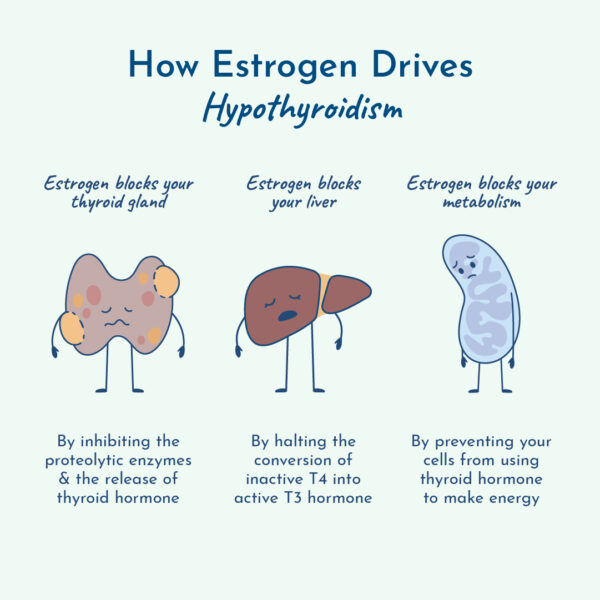
While the exact mechanism(s) that cause hot flashes are still not entirely understood, there are certain triggers that are well known to produce hot flashes, which can be corrected.
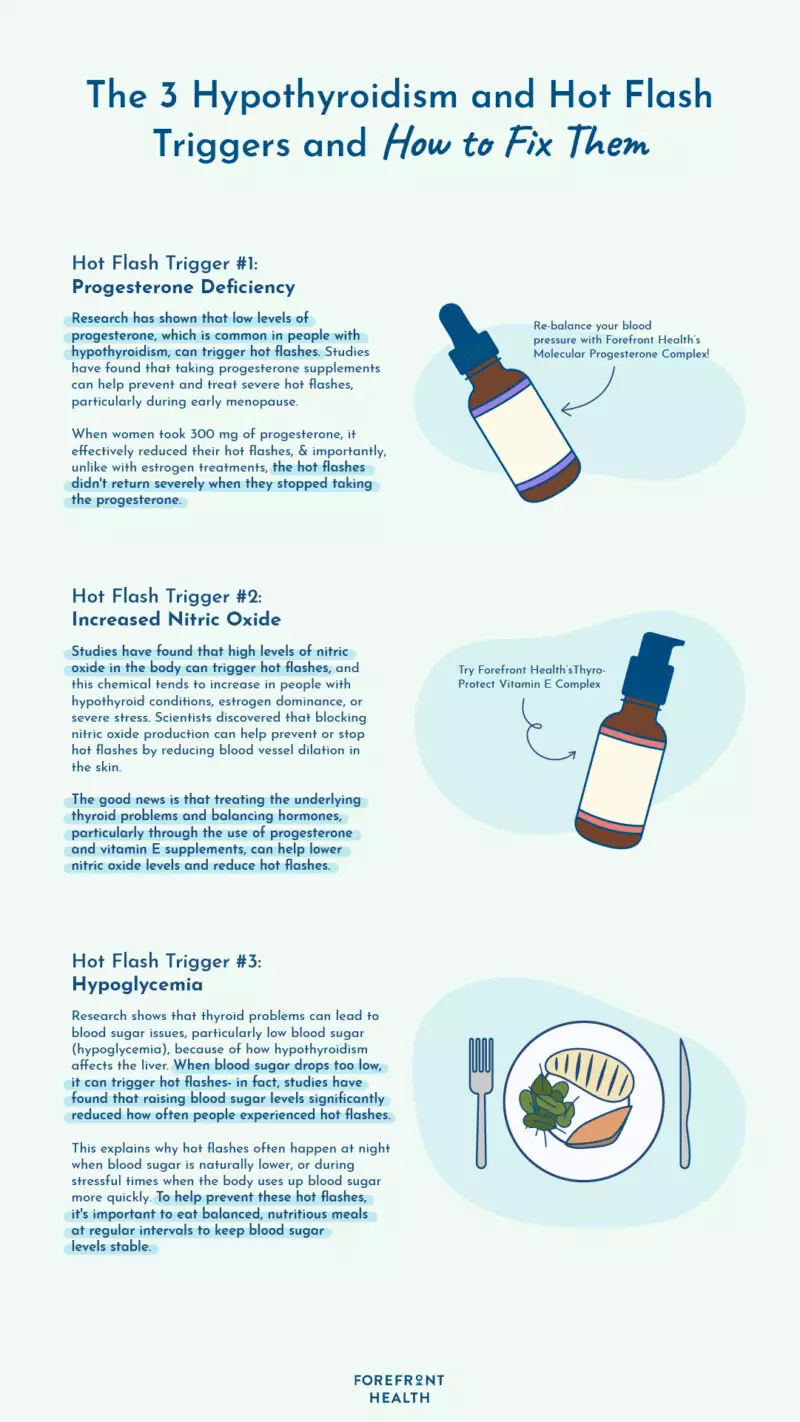
The 3 Hypothyroidism and Hot Flash Triggers and How to Fix Them
Here’s what we do know…
Some studies have demonstrated that hot flashes can be triggered by certain imbalances, and that correcting those imbalances can effectively prevent or reduce the risk of a hot flash occurring.
These hot flash triggers include:
- Progesterone Deficiency
- Increased Nitric Oxide
- Hypoglycemia
What’s interesting is that these imbalances are also commonly found in hypothyroidism and caused by estrogen dominance.
Wait… what?
How can that be?
If these hot flash triggers are caused by estrogen dominance (and hypothyroidism), then why would estrogen improve hot flash symptoms?
How can something be both part of the problem and the solution at the same time?
This is exactly what continues to confuse so many.
The truth is that while large amounts of estrogen may alleviate the severity of hot flashes, it’s certainly NOT part of the solution.
Studies show that estrogen effectively lowers both body temperature and the environmental temperature at which your body begins to release heat.
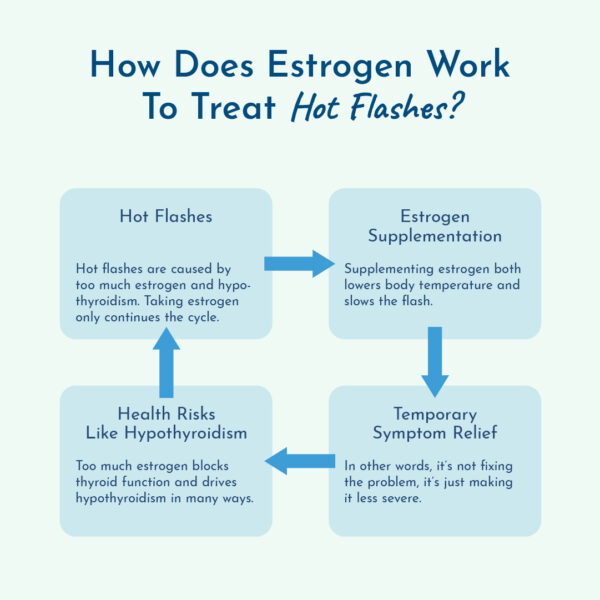
Chronic hormone replacement therapy alters thermoregulatory and vasomotor function in postmenopausal women. https://www.ncbi.nlm.nih.gov/pubmed/9262443 “These results suggest that 1) chronic ERT [Estrogen Replacement Therapy] likely acts centrally to decrease Tre [temperaure], 2) ERT lowers the Tre at which heat-loss effector mechanisms are initiated, primarily by actions on active cutaneous vasodilation, and 3) addition of exogenous progestins in HRT effectively blocks these effects.”
The higher your body temperature (more heat) and the faster the flash (release of that heat), the more severe the hot flash.
Supplementing estrogen both lowers body temperature (less heat) and slows the flash (release of heat), thus reducing the symptom.
In other words, it’s not fixing the problem.
It’s just making it less severe.
That makes estrogen great for your hot flashes, but (as we’ve already established) horrible for your health.
It’s never a good idea to try to solve one problem only to create a bigger and more serious problem in the process.
Instead, focus on fixing the underlying cause of your hot flashes by fixing these three hot flash triggers.
Hot Flash Trigger #1: Progesterone Deficiency
As mentioned previously, progesterone deficiency is common in hypothyroidism.
Not only is progesterone deficiency known to promote hot flashes, restoring progesterone levels is known to prevent them.
Progesterone for hot flush and night sweat treatment–effectiveness for severe vasomotor symptoms and lack of withdrawal rebound. https://www.ncbi.nlm.nih.gov/pubmed/22849758 “In summary, progesterone is effective for severe VMS and does not cause a rebound increase in VMS when stopped.”
In this study of early menopausal women, 300 mg was shown to be effective against severe hot flashes.
Also, when the progesterone was stopped, the hot flashes didn’t come back with a vengeance as they do when you stop estrogen.
Hot Flash Trigger #2: Increased Nitric Oxide
Nitric oxide levels are known to rise in hypothyroidism, estrogen dominance, and in response to severe traumatic stress.
It’s also known to trigger hot flashes.
Nitric oxide synthase inhibition attenuates cutaneous vasodilation during postmenopausal hot flash episodes. https://www.ncbi.nlm.nih.gov/pubmed/20505548 “CONCLUSIONS: These data demonstrate that the mechanism for cutaneous vasodilation during hot flash episodes has a nitric oxide component.”
Research also shows that inhibiting nitric oxide can prevent or stop hot flashes from occurring.
Regulating thyroid function and metabolism will effectively lower nitric oxide levels, as can addressing the underlying estrogen dominance, which we often do with our Molecular Progesterone Oil and our Vitamin E Complex.
Hot Flash Trigger #3: Hypoglycemia
Hypothyroidism is also well known to promote blood sugar issues and hypoglycemia, due to hypothyroidism’s effects on your liver.
Being hypothyroid and prone to low blood sugar also makes you more susceptible to hot flashes.
Menopausal hot flash frequency changes in response to experimental manipulation of blood glucose. https://www.ncbi.nlm.nih.gov/pubmed/14501548 “RESULTS: There was a significant reduction in the incidence of hot flashes during the experimental elevation of glucose concentrations (130 to 140 mg/dl) compared to the fasting state (<110 mg/dl) (t= -2.4, df= 9, p=.04).”
This is why hot flashes tend to occur more frequently at night when blood sugar is often lowest and during times of stress when blood sugar is used up more rapidly.
We always recommend eating the proper balance of nutrition, and frequently enough, to keep blood sugar stable.
Hypothyroidism is very common in menopause, and needless to say I’ve worked with a lot of menopausal clients.
Correcting these three hot flash triggers has been instrumental in alleviating hot flashes with many of them.
Yet, it’s not only menopausal women who suffer.
I’ve also worked with non-menopausal women who experience hot flashes, and these same tips apply to them as well.
Unfortunately, the current medical approach to menopausal symptoms and hormone replacement therapy is extremely dangerous.
Putting yourself at unnecessary risk of developing life threatening diseases like cancer, thyroid disease, and stroke is surely not the solution…
…especially when there are other viable options, like progesterone supplementation, that can fix hot flashes and protect you from these very diseases at the same time.
KEY IDEA
Estrogen is not the safest way of treating menopausal hot flashes and can actually increase your risk of cancer and thyroid disease, despite reducing symptoms. There are three main triggers for hot flashes- progesterone deficiency, increased nitric oxide levels, and low blood sugar. These triggers are often connected to thyroid problems and can be managed through natural approaches like progesterone supplementation, proper nutrition, and blood sugar regulation, rather than relying on potentially dangerous estrogen treatments.


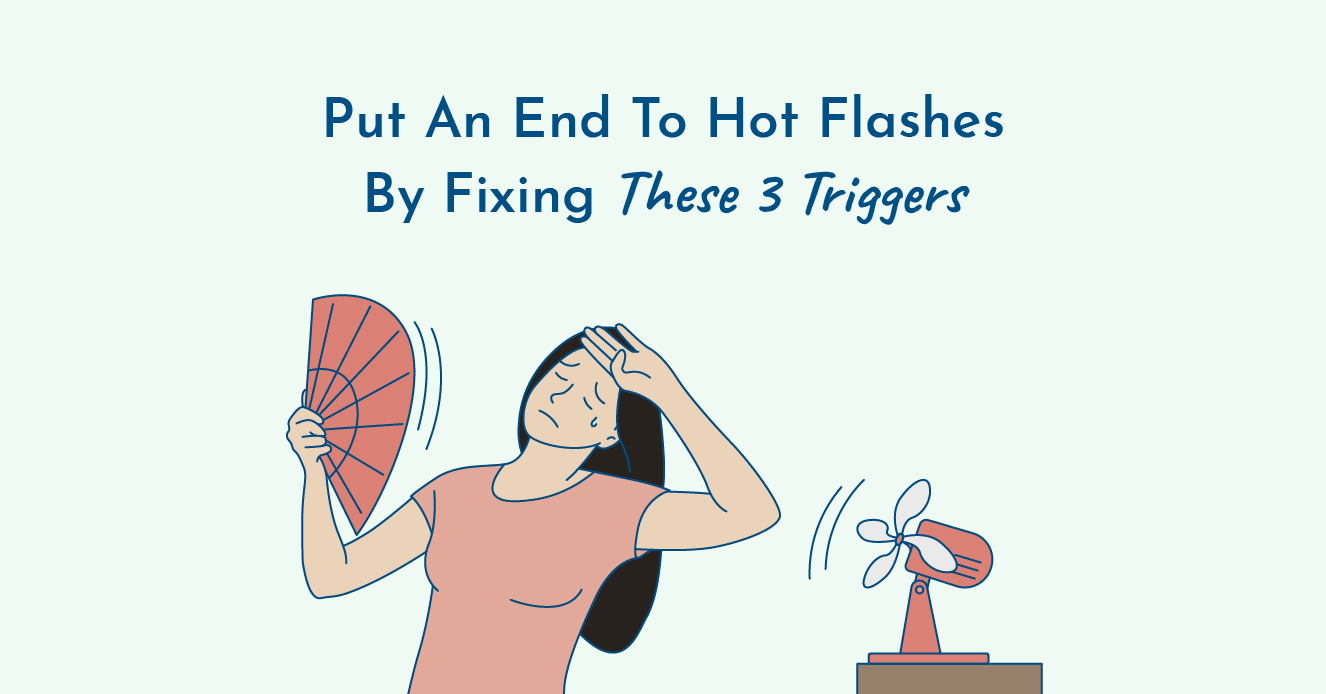
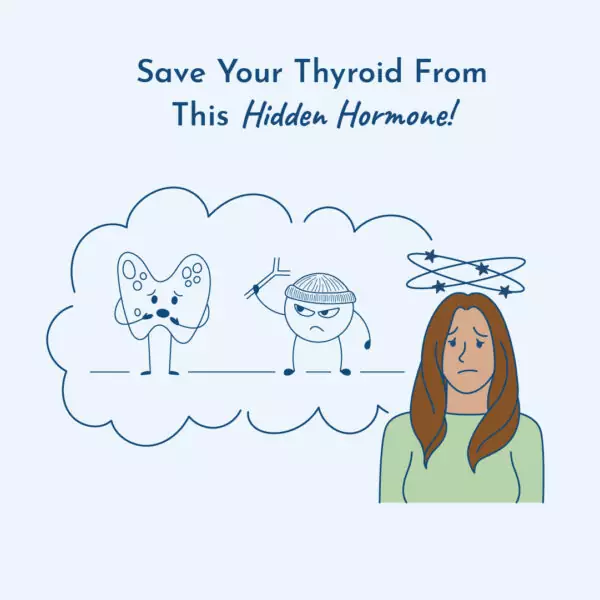

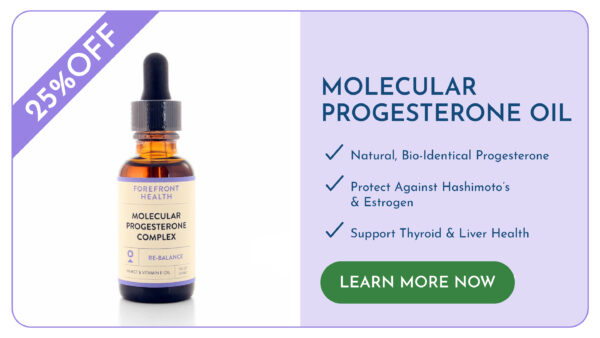
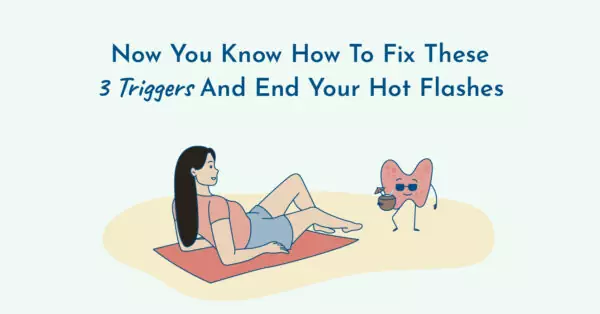

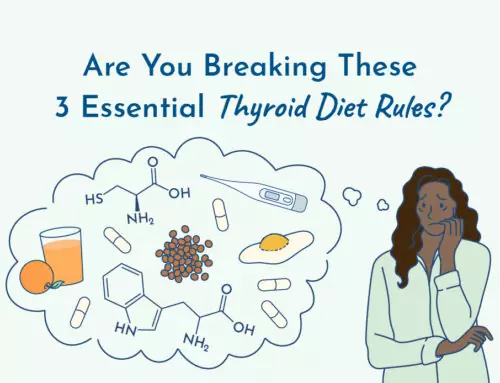
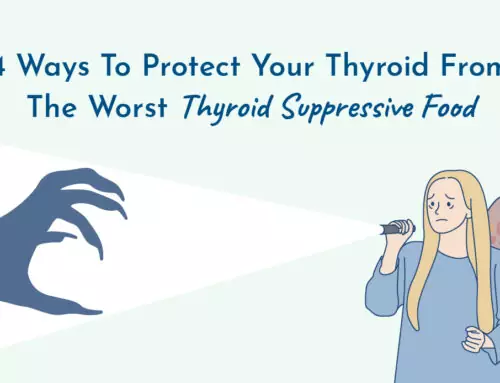
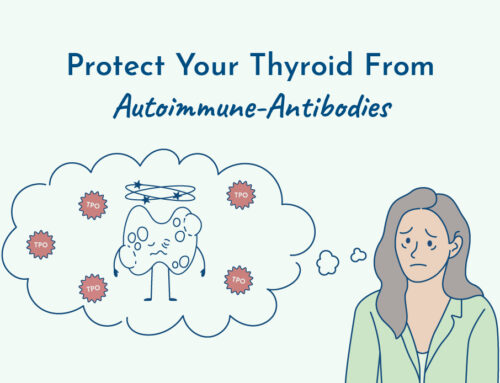
Hi there,
I am 29 years old and was diagnosed with hypothyroidism when I was 19. I have been taking T4 ever since. I have dramatically cleaned up my diet and lifestyle over the years and my hormones all seem to be “within range” based on blood tests (which is why I am apprehensive to try progesterone or any other type of hormone). For the last 4 or 5 years or so, I notice that the few days leading up to and during my period I get these strange hot flashes (or what I think they are considered hot flashes). I’ll get super hot for about a minute and my face turns bright red a few times a day. It’ll cool off a couple of minutes later but its so intense that people ask me if I’m okay and that I’m so red out of no where! This doesn’t happen too much during the rest of the month, just the 3 or 4 days prior to and the 3 days during my period. Aren’t I way too young for that? What could this possibly mean?
Hi Veronica, the short answer is that no, you’re not too young. Estrogen dominance affects people (men and women) of all ages. The important thing is that you’ve already correlated it with your menstrual cycle which is always a big clue that it’s related to estrogen/progesterone. Unfortunately lab testing for some hormones (like estrogen) isn’t accurate at all. I discuss this in detail here: https://www.forefronthealth.com/test-for-estrogen-dominance/
THANK YOU. I’m 53, post-menopausal, and I’ve been working with a functional med doc for my hashis and hypothyroid. My hot flashes were unbearable when I stopped HRT. She put me on bio-identical prog and estrogen, but my hot flashes were coming back worse, so she upped my bio-identical estrogen. All that did was make me fatter and feel worse. My BT was averaging 96.4. I’m on NDT and T3 (a lot of it) but I knew it wasn’t getting through, especially since my BTs are so low. This explains SO much. Thank you for all your helpful info. I’ve stopped the estrogen cream and will start your progesterone oil as soon as it arrives.
I have a question ,, on the bottle it says 3 mg progesterone in one drop, and it reccommends 3 to 4 drops several times per day. but in the article on hot flashes … 300 mg per day is needed. That would be a hundred drops per day .. is that what he’s saying?
Thanks
Toos
Hi Toos, that research study was for patients with severe cases of hot flashes/flushes. In some cases, large amounts of progesterone are necessary and warranted.
Interesting article. I had to get off my bio-identical estrogen (long story), but stayed on my bio-identical progesterone. 6 months later, I’m now testing hypothyroid via low T3, whereas my thyroid panel has always been in the normal range when I was on supplemental estrogen. Your article says that estrogen dominance can block the liver from converting T4 to T3, but it seems that my conversion is now worse when I am no longer using estrogen therapy. I have had hormone tests in the past to check my hormone levels – saliva, blood, urine – none of these tests indicated estrogen dominance, not even when i was on estrogen. In fact, all the tests would indicate the opposite that I probably was under-dosed with estrogen, as I was often barely or not even in the post-menopausal range, but progesterone was good. I’ve been post menopausal for 3 years. So, in your opinion, does estrogen deficiency even exist and if so,what are the symptoms and how do you treat it, if not with supplemental estrogen?
Hi Tasha, this is one reason why we never rely on lab testing alone. To get to the bottom of that it would require some additional testing and having temp/pulse measurements during that time would have helped as well. Estrogen also inhibits metabolism and the use of T3, so one would have to determine if T3 levels were higher because you weren’t using it efficiently. Interpreting labs properly isn’t as easy as looking at reference ranges. Also keep in mind that you can’t accurately test estrogen by blood, saliva, or urine. I’ve written about this here: https://www.forefronthealth.com/test-for-estrogen-dominance/
Hi,
the study said -oral micronized progesterone (Progesterone, 300 mg at h.s. daily)
oral means swallow or rub in gums? The absorbing is the same?
For how long?
And – can I take it like 50-60mg 5 times/day to get the same results?
thanks
Hi
How do you treat symptoms such as low libido, thinning hair and low mood? I’ve been on progesterone therapy for the past 10 years (I’m also hypothyroid and treat with direct T3) but these symptoms still persist?
Many thanks
Reminds me of the ol’ Hair of the dog, regarding estrogen and reducing hot flashes. You may feel a bit better with that drink the next day, but it sure is not fixing the damage done by the alcohol. I am guessing this is what happens using estrogen to reduce hot flashes, good for short term, not for long term. Same with N-3 oils, anti-inflammatory in the short term, but stored for increase damage in the long term.